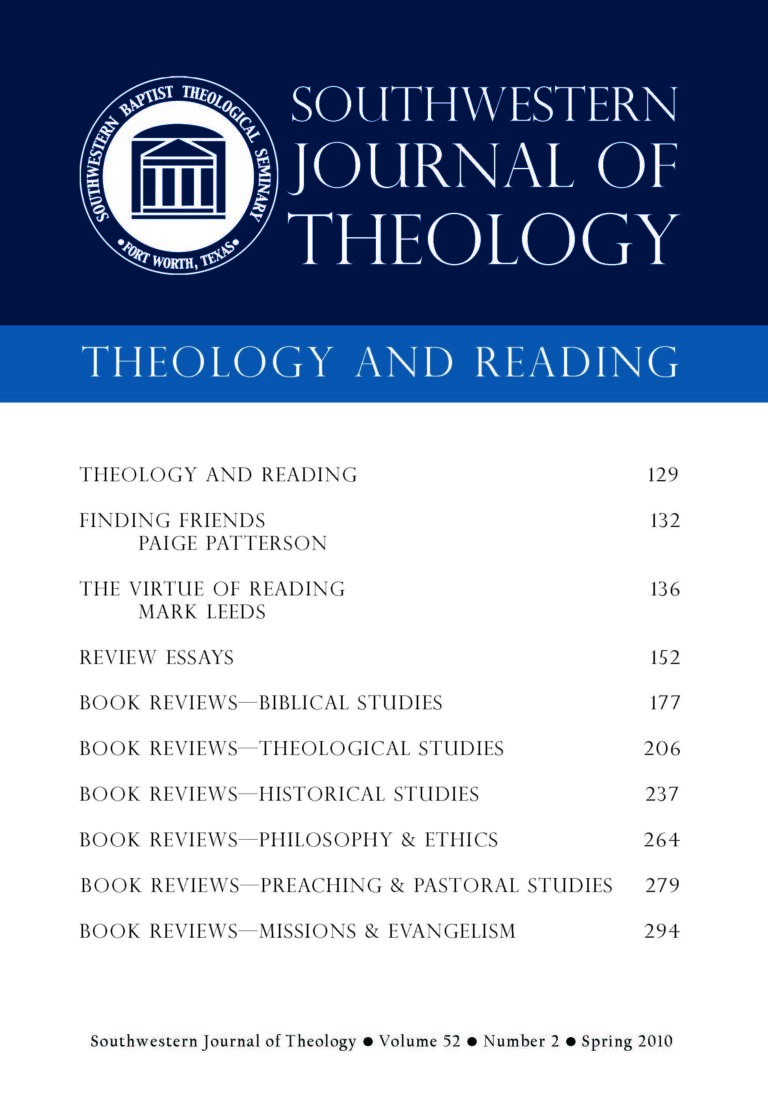
Theology and Reading
Southwestern Journal of Theology
Volume 52, No. 2 – Spring 2010
Managing Editor: Malcolm B. Yarnell III
By J. Daryl Charles. Grand Rapids, MI: Eerdmans, 2008. 346 + x pages. Softcover, $34.00.
In a culture that all too often renounces ethical practices consistent with a Christian worldview, the church needs to voice a moral consciousness that challenges the ebb and flow of postmodern ethics. In order to provide such a moral voice, Christians must be able to bridge the gap between Christian doctrine and public action. God has given us such a means to bridge this gap in the natural law. Indeed, without the natural law—the law written on the heart—Christians may not be able engage the surrounding culture. In the words of J. Daryl Charles, “In the end, apart from the natural law, we appear to lose any basis upon which to build a moral apologetic and to preserve civil society” (152).
In this volume, Charles addresses the notion of natural law and relates it bioethical issues. His primary goals in Retrieving the Natural Law are threefold: (1) to offer an explanation of the nature and history of natural law thinking, (2) to expose the inadequacies of natural law emphases in the Protestant tradition, and (3) to apply the “moral first things” of the natural law to contemporary bioethical debates.
First, Charles stresses natural-law thinking as essential to human flourishing, necessary to moral order, and integral to Christian witness. As Charles explains, this type of natural law thinking has been present in the church throughout her history—from the apostle Paul to Augustine, from Aquinas to Calvin, from C.S. Lewis to John Paul II. At the heart of Charles’ argument is that natural law is not contrary to (or even peripheral to) Christian doctrine, but rather it is understood through general revelation, supported by special revelation, and necessary for the flourishing of human civilization. According to Charles, those who would deny natural law are unable “to help cultivate any sort of public consensus about what is good, what is acceptable, what is just; they can only talk among themselves” (60). So Charles insightfully recognizes that natural law simultaneously undergirds both ethics and evangelism
Second, Charles exposes a modern Protestant aversion to natural law. While Catholic theologians have often faithfully carried on the natural law tradition (particularly in the writings of Aquinas and John Paul II), unfortunately, Protestantism has not done the same. Charles argues that this aversion to natural law by modern Protestants produces disastrous results. He states, “By removing ethical intuition from universal knowledge and reason or denying that ethical norms are rooted in the order of creation, Protestants have eliminated the theological basis for natural law. And in so doing, they have lost any basis for a common moral grammar with which to enter moral discourse with non-Christians in a pluralistic social context” (21). He focuses on this Protestant rejection of natural law primarily in the writings of Karl Barth, Jacques Ellul, John Howard Yoder, Stanley Hauerwas, and H. Richard Niebuhr. Charles suggests that in order for Protestants to join Catholics in voicing a unified, robust social ethic, the natural law tradition must be revived and reapplied to modern ethical issues (and bioethical issues in particular).
Third, Charles applies natural law thought to contemporary issues within medical ethics. He approaches bioethical debates in two ways. On the one hand, he addresses bioethical issues that face the current culture on “three principal fronts: beginning-of-life issues, life-enhancement issues, and end-of-life issues” (208). In particular, he analyzes euthanasia as a test case through the lens of German academic thought from 1890 to 1933. On the other hand, he also approaches contemporary bioethics by endorsing virtues consistent with the natural law and necessary for rightly responding to bioethical issues and promoting a culture of life. For example, he emphasizes the need for “redemptive suffering” when considering euthanasia and abortion; he encourages telling the truth in love when engaging a culture of death; and he stresses tolerance and compassion, but only insofar as these virtues are guided by a view toward the public good. Charles demonstrates that medical ethics (like ethics more broadly) is about fulfilling our telos by developing the appropriate virtues consistent with natural law.
I highly recommend this work. It is at once theoretically robust and readily pragmatic. In line with Lewis’ The Abolition of Man, Charles offers a glimpse of what we might be without God’s common grace—and the prospects are not good. We rely on the law written on the heart for the very order of human life and activity. In looking at how we might rely on natural law in bioethics, Charles presents an important volume for medical professionals who want to think deeply about the faith in practice and for theologians who want to take the essentials of the Christian faith into the public square.





